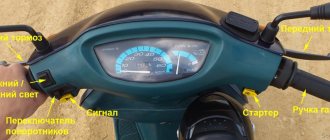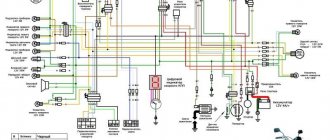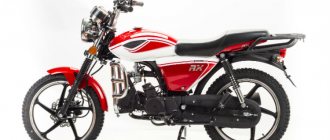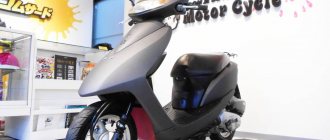Types of batteries for scooters
The following types of scooter batteries are currently being produced.
Sealed battery
Calcium acid batteries
Conventional acid batteries are rarely used in mopeds and scooters, since they do not have a sufficiently reliable rollover protection system. Therefore, as a rule, in modern realities, only sealed battery models made using AGM technology (maintenance-free batteries) are used. The principle of operation of such a battery is quite simple - a chemical reaction of lead dioxide occurs in a sulfuric acid environment with the release of electric current.
Pros of an acid battery:
- Widely popular. Batteries of this type are easily available and have a low price compared to others.
- Stable operation under heavy loads.
- Recyclable.
Disadvantages of an acid battery:
- Reduced power density. Therefore, acid batteries are characterized by increased weight and, therefore, inconvenience of use.
- When the charge is less than 20%, the service life is significantly reduced. Recharging is recommended at 40% charge. This will provide 1500 charge-discharge cycles.
- Be sure to periodically check the electrolyte level and replenish it if there is a deficiency.
- Failure can happen at any time and unexpectedly.
Maintained scooter battery
To achieve maximum performance of a lead acid battery, you must adhere to a number of mandatory rules. The insulation must be in excellent condition and free of leaks. Prevent foreign elements from entering the electrolyte - this will cause delamination of the plates and a decrease in service life. The battery capacity should be checked periodically.
For correct recharging, you need to use a charger with a current in the range of 10% of its total capacity. It is strictly forbidden to use chargers with a higher current strength - otherwise, each recharging cycle will cause irreparable damage to the battery. The charging time of an acid battery directly depends on its capacity.
Acid batteries can be either maintenance-free or maintenance-free; for mopeds and scooters, it is highly recommended to use maintenance-free models.
Gel batteries
The main difference between a gel battery and a regular battery is the gel-like consistency of the acid. And the main advantage is that there is no need for maintenance. With proper operation, the need for service can be completely avoided.
Gel battery for scooter
Pros of a gel battery:
- Operation regardless of the position of the battery (standing, on its side, etc.)
- Does not leak even with damaged insulation.
- Increased service life.
- High starting current.
The disadvantages include:
- Overcharging is destructive. Therefore, you need to monitor the battery indication.
- Severe frosts affect service life.
- Increased cost compared to other types of batteries.
Gel batteries are quite unpretentious in service. It is not for nothing that it is classified as maintenance-free. The main rule is not to overexpose it to the cold. If you plan not to use it for a long time, then it is enough to remove it from the moped or scooter in a charged state and store it warm. Due to its low self-discharge ability, a gel battery will only drain by 10-15% in a year.
Charging a gel battery requires special equipment, and not all service centers have such equipment in stock. This is due to the fact that such batteries are quite rare at the moment.
IMPORTANT!!! When recharging, be sure to observe the voltage level of the electric current. It should not be higher than its threshold. Otherwise, the service life of the battery will be significantly reduced due to delamination of the plates under the influence of the released gas. And since the gel battery is sealed, this can lead to increased pressure inside and a subsequent explosion.
Lithium-ion batteries
The main purpose of such batteries is to use them in racing vehicle models. But they have proven themselves quite well on regular scooters or mopeds. If you follow the operating rules, then this type of battery is safe and does not pose a threat to the environment.
Pros of lithium-ion batteries:
- No memory effect.
- Low self-discharge ability. 10-20% per year.
- The operating temperature range ranges from -20° to +50° Celsius.
- With irregular use, the service life varies within 15-20% per year.
- The service life with proper use exceeds the limit of 10 years.
- Light weight and easy to use.
Lithium Ion Battery for Scooter
Cons of Lithium Ion Batteries:
- High price.
- Overload vulnerability.
- Fear of deep discharges.
- Lithium is a very active element, so if the seal is broken, a fire or explosion may occur.
- Difficulty in recharging at low temperatures.
If you follow the basic rules, lithium-ion scooter batteries will last more than 10 years. To do this, do not leave lithium-ion batteries in a discharged state for a long time. If storing, charge it halfway and place it in a cool, dry place. Do not exceed the recommended charging current. Do not overheat or expose to prolonged frost. It is recommended to completely discharge it once every three months.
Important! When charging a lithium-ion battery, use only the original charger. This is due to the fact that in most cases, part of the charging system is built into the battery itself, and the external network adapter only rectifies the electric current in the household network. Otherwise, the battery life will be significantly reduced.
Types
Today there are such types of batteries for scooters and mopeds.
Acid-calcium
A standard acid battery is used infrequently, because it is not reliable enough and is not protected from overturning.
Nowadays, sealed ones produced according to the AGM principle are more popular. They are maintenance-free and have a simple mechanism of action. Electric current is produced due to the oxidation of lead dioxide.
Advantages:
- They are in great demand and affordable.
- Reliable operation under heavy loads.
- Can be recycled.
Flaws:
- They are overweight compared to others (which is not always convenient).
- It should be recharged when the charge drops to forty percent. This guarantees one and a half thousand charge-discharge processes.
- It is imperative to maintain electrolyte levels.
- Breakdown is always possible, including unexpectedly.
For stable and long-lasting operation of such batteries, you should follow some instructions. Prevent leakage and any objects from entering the electrolyte. This may lead to failure. It is necessary to recharge on time.
For a normal charging process, it is recommended to use a device whose current is ten percent of the battery capacity. Any other devices may damage the battery.
Acid-based battery devices are either serviceable or not. But for motorcycles, it is important to use maintenance-free batteries.
Gel
They differ from standard ones in that the acid is contained in the form of a gel. The most important advantage is the lack of maintenance during use. If you follow all the rules, you can avoid the service.
How to choose the right battery for a scooter
When visiting a motorcycle store, always give preference to a battery with rollover protection - this is the most important parameter for a scooter battery. It is also advisable to give preference to models with a stated long service life and high starting current to guarantee successful starting even in extreme cold conditions.
If the choice falls on an acid battery, if possible, choose batteries with AGM technology. They are most resistant to vibration and overturning. The most preferred batteries are 12 volts and a current of 4 amperes/hour. But if necessary, you can choose a more powerful option.
Rules for choosing batteries for scooters or mopeds
The main point when choosing a unit is the battery’s resistance to capsizing.
You should also choose batteries with a long service life and a high initial current - for reliable operation at low temperatures. Among acid-base batteries, you need to choose those made using the AGM method. They are more reliable when turning over and shaking.
The most popular batteries are with parameters of twelve volts and four ampere hours. If desired, you can find more powerful devices.
Which memory is better to use?
When purchasing a scooter or moped, it is strongly recommended to read the operating instructions. It describes which batteries are suitable for the selected model and which chargers to use.
Do not try to charge the battery of a charger that is not suitable for this type of battery.
Do you have a scooter or moped? Tell us in the comments what kind of battery you use and how much you like it. This will help make the site content more complete and useful.
Which battery to buy
Primary and probably most serious: beware of purchasing a counterfeit battery . In the markets, they may even give you a partially empty battery - with a reduced number of plates! To prevent this, you don’t need to pay money for the first cheap battery you see, but it is advisable to spend a little time before purchasing on the Internet searching for official battery sellers who provide them with a warranty of at least 1 year and documents, or resort to recommendations professionals from the same web. Of course, someone may say that the best solution is to come to the official service center of the brand and buy the battery recommended by the scooter manufacturer. This is quite accurate, but not the most accessible solution.
If the model of your scooter is more or less common and was produced exclusively for one market (European, American or Japanese), then the trading organization has a chance to look at the price list and choose a battery based on the scooter modification or battery encryption. It is perfectly. But if you are the owner of something unusual, domestic, or the model was sold in different markets in various configurations, then the ruler will help you! Measure the seat, secure the placement and shape of the terminals, and only then look through catalogs on websites or call stores. If the battery you found fits perfectly into place, but has small deviations in capacity, it’s not a disaster; differences of 1-2 Ah are not fatal.











